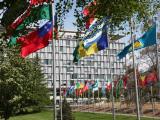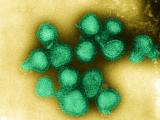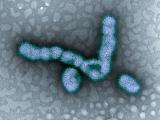Jul 13, 2009 (CIDRAP News) – The World Health Organization (WHO) recommended today that governments put healthcare workers first in line for pandemic H1N1 vaccine when it becomes available and that countries should choose other priority groups on the basis of their own situations.
The agency said it's important to vaccinate health workers first in order to keep health systems functioning. After that, governments should consider other groups that are most vulnerable to severe H1N1 infections, such as pregnant women, people with chronic health problems, and young adults.
At the same time, the WHO reported that vaccine manufacturers growing the candidate H1N1 vaccine viruses are getting relatively poor yields—only about 25% to 50% as much antigen as with seasonal H1N1 vaccine viruses. That suggests it may take longer for manufacturers to fulfill their existing vaccine contracts and to begin making vaccine for countries that have not yet ordered doses.
At a news conference today, Dr. Marie-Paule Kieny, director of the WHO's initiative for vaccine research, said the low yields are not yet considered a major concern and that the agency's collaborating laboratories are working to develop better-yielding strains.
SAGE advice
The recommendations released today emerged from a meeting last week of the WHO's Strategic Advisory Group of Experts on Immunization (SAGE), the agency's top advisory body on vaccines.
"SAGE recommended first that healthcare workers should be immunized in all countries to maintain a functional health system as the pandemic evolves," Kieny said.
After healthcare workers, the WHO said in a news release, governments should consider the following groups for vaccination, depending on local conditions: pregnant women, people (over 6 months old) with chronic medical conditions, healthy people between 15 and 49 years old, healthy children, healthy adults aged 50 to 64, and healthy older adults.
Last week, US Health and Human Services Secretary Kathleen Sebelius said priority groups for H1N1 vaccine would include schoolchildren, non-elderly adults with health problems, pregnant women, and healthcare and emergency workers, but she did not put any one of those ahead of the others. Elderly adults are believed to have some protection from the novel virus because of past exposure to H1N1 viruses and vaccines.
Kieny said vaccine allocation plans will depend on how countries balance the three major objectives of immunization: reducing transmission, reducing sickness and death, and protecting the healthcare system. If a country's primary aim is to limit spread of the virus, authorities might put children ahead of other groups, she observed.
Seasonal vaccine nearly all made
In other deliberations, SAGE determined that production of seasonal flu vaccine for the northern hemisphere will be more than 90% complete by the end of July, Kieny reported. Therefore, manufacturers will not need to curtail seasonal vaccine production in order to start making pandemic vaccine, she said.
Further, because some pandemic vaccines involve new technologies, the best possible post-marketing surveillance will be important, SAGE said. The group said findings should be shared with the world quickly so that countries can adjust their immunization strategies.
The advisory panel also said that the production and use of vaccines containing oil-in-water adjuvants and of live attenuated vaccines should be encouraged, since initial vaccine supplies will be limited and there is a potential for drifted strains of the H1N1 virus.
Low yields with current candidates
The problem of low production yields was revealed in SAGE meeting documents that the WHO recently posted online. In response to questions today, Kieny said, "It's not known what's happening, but the output they have at the end is 25% to 50% of normal yield."
"For the first series of [vaccine] strains that were generated, we unfortunately didn't come up with a good yielder," she said. "In order to remedy that, the WHO laboratory network is trying to generate new vaccine viruses from wild type viruses generated from patients."
Kieny asserted that the low yields are not a big problem for the timing of vaccine production now. Using the current strains, manufacturers are harvesting enough antigen for clinical trials, she said. Also, regulatory authorities have said that when new candidate strains become available, it won't be necessary to conduct "bridging studies" to compare them with the current strains, because they will differ only in yield, not in antigenicity, she said.
"We hope that as soon as possible the situation can be improved upon, but for the timing there is no reason to be overly anxious about that," Kieny said.
However, in slides that Kieny presented at the SAGE meeting, she stated that a lower-yielding vaccine "would considerably push back the timelines." The presentation, which is available online, suggests that poor yields could delay manufacturers' fulfillment of current vaccine orders by 2 to 6 months.
The presentation says existing government orders for H1N1 vaccines total 850 million to 900 million doses. On average, governments have ordered one dose per person, but most have options for, or are considering ordering, two doses per person, which would increase total orders to about 1.8 billion doses.
If vaccine yields are normal, if a relatively low dose of 8 micrograms (mcg) is sufficient, and if governments order an average of one dose person, vaccine manufacturers in the wealthy countries could fulfill their current vaccine orders in November, according to Kieny's estimate.
But if vaccine yield is only half of normal, with other conditions the same, it would take until January for the manufacturers to fulfill their vaccine orders, she projects. An even lower yield, such as one third of normal, could delay the completion of production until April, according to her presentation.
Other factors could also slow production, according to Kieny's estimates. For example, using a dose of 15 mcg instead of 8 mcg could delay the fulfillment of vaccine orders from November until February (still assuming one dose per person).
In other comments at the press conference, Kieny said the manufacturers of live attenuated H1N1 vaccines have not had a problem with yield so far. The appropriate dose for these vaccines is not yet known, but "in terms of growth they seem to be behaving normally," she said.
In fielding questions, Kieny said that uncertainty about safety has prompted a number of vaccine makers not to use adjuvants in their H1N1 vaccines. She said some companies have never worked with adjuvants, and combining an adjuvant from one company with a vaccine from another raises safety concerns.
One of Kieny's SAGE meeting slides shows that only 12 of 33 currently proposed H1N1 vaccine formulations contain adjuvants.
See also:
Jul 13 WHO news release
http://www.who.int/csr/disease/swineflu/notes/h1n1_vaccine_20090713/en/index.html
Links to SAGE meeting documents:
http://www.who.int/immunization/sage/previous_july2009/en/index.html
Kieny slide presentation
http://www.who.int/immunization/sage/3.MPK-SAGE_7_July.pdf


















